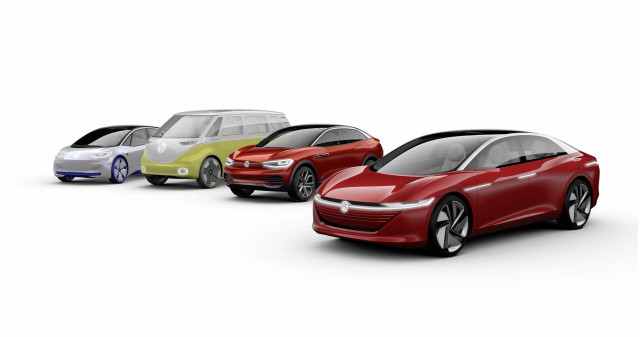
Volkswagen is aiming for affordability, so it doesn’t want to pack every model with the maximum range. The automaker referred to base battery packs of, tentatively, 48 kwh and 62 kwh and said that we should expect a range of 175 to 300 miles in the Worldwide Harmonized Light Vehicle Test Procedure (WLTP). Although there’s no lock-step conversion to EPA range—they’re different driving cycles—that likely means a range comparable to the current Nissan Leaf’s 151 miles, up to (or perhaps better than) the 258 miles of rated range for the 2019 Hyundai Kona Electric. It’s likely that doesn’t include the extended 82-kwh pack that could arrive a bit later or be limited to a few flagship models.
Rear-wheel drive, 50/50 weight distribution. The MEB vehicles, at the base level, will offer rear-wheel drive only and a near-equal weight distribution front to rear—two traits European sport sedans have long boasted of. All-wheel drive, via an additional front motor, will be available.
Two different kinds of motors. Every MEB vehicle will have a DC permanent magnet motor, mounted within a modular rear axle assembly, and chosen for its combination of performance and cost-effectiveness. But dual-motor models with all-wheel drive will have what officials confirmed is the same motor design as what goes into the Audi e-tron—a current-excited synchronous motor that VW’s sibling luxury brand chose because of its strong recuperation (brake regen) potential and lack of rare-earth elements.
Two gear ratios. It’s almost certain there will be multiple power levels offered across these different electric models. But to accommodate performance versions there will be two different reduction ratios used for the rear motor.
Liquid cooling. Component cooling and heating will be split into two circuits: a high-temperature one for the motors, and a lower-temp one for the battery and power electronics. All models will have resistive heating for the cabin, while a heat-pump system will be available and could help heat or cool components.
VW is extremely vague about the performance of the MEB vehicles. For instance, in a release it points out that the ID prototype can get to 62 mph in less than eight seconds, with a top speed of 99 mph. But then it says: “Electric drive motors offering either more or less power may be considered for the 2020 series version.” One thing we will see, officials confirmed, is an approach that offers multiple performance levels.
The MEB models ride on a completely new end-to-end architecture, called E3, and may be the first in the VW Group to get over-the-air updates that can tweak performance traits. Upgrades via the cloud will affect both “performance and technical desirability” through the vehicle’s life cycle, according to VW. Three new core processors are also part of the platform. Called ICAS1, ICAS2, and ICAS3, these are dedicated to vehicle sensors, HMI, and safety systems, respectively.
Familiar exterior sizes, more interior space. Compared to existing platforms that accommodate internal combustion engines, VW says that MEB offers more passenger space and a somewhat higher seating position, with less front and rear overhang, no drive tunnels, and more space for passengers and cargo. The MQB platform, which underpins everything from the Golf to the Tiguan, was used as a starting point, and many of the critical dimensions aren’t far off—yet Volkswagen has carried over next to nothing.


0 Comments